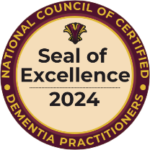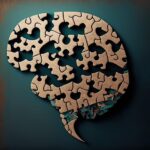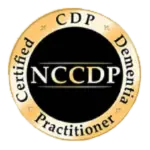Aphasia and dementia are distinct yet often interconnected neurological conditions that significantly impact communication and cognitive functions. Aphasia, commonly resulting from stroke or brain injury, impairs language abilities, while dementia, a progressive disorder, affects memory, reasoning, and language. This article explores the connection between aphasia and dementia and discusses treatment approaches, drawing on recent scholarly research.
Understanding the Connection
Aphasia and dementia can co-occur, particularly in specific types of dementia such as Alzheimer’s disease and frontotemporal dementia (FTD). Primary progressive aphasia (PPA), a subtype of FTD, exemplifies the intersection of these conditions. PPA is characterized by a gradual decline in language abilities, reflecting the overlap between aphasia and dementia. Research by Gorno-Tempini et al. (2018) highlights that individuals with PPA often exhibit symptoms of both language impairment and broader cognitive decline, underscoring the intertwined nature of these disorders.
Shared Pathophysiology
The overlapping pathophysiological mechanisms in aphasia and dementia contribute to their co-occurrence. Neurodegenerative processes, such as tau and amyloid-beta pathology in Alzheimer’s disease, can affect brain regions responsible for language, leading to aphasic symptoms. Similarly, vascular dementia, often resulting from cerebrovascular events, can cause both cognitive decline and aphasia. A study by Leff et al. (2019) indicates that white matter lesions, common in vascular dementia, disrupt neural networks involved in language processing, thereby linking the two conditions.
Treatment Approaches
1. Speech and Language Therapy (SLT)
Speech and Language Therapy (SLT) is a cornerstone treatment for both aphasia and dementia. SLT aims to improve communication abilities through personalized exercises and strategies. A study by Baker et al. (2020) demonstrated that SLT significantly enhances language skills in patients with PPA. Techniques such as semantic feature analysis and phonological components analysis are employed to target specific language deficits, showing promising results in maintaining communication abilities.
2. Cognitive-Communication Therapy
Cognitive-Communication Therapy addresses the broader cognitive aspects of communication. This approach is particularly relevant for individuals with dementia who experience language and cognitive impairments. Research by Rogalski et al. (2021) highlights the effectiveness of cognitive-communication therapy in improving both language and cognitive functions in patients with Alzheimer’s disease. The therapy includes exercises that stimulate memory, attention, and executive function, enhancing overall communicative competence.
3. Integrative Approaches
Integrative approaches that combine elements of SLT and cognitive therapies are gaining traction. A recent study by Kiran et al. (2023) explored an integrative therapy program for patients with PPA, incorporating language exercises, cognitive stimulation, and social interaction. The results indicated that this comprehensive approach led to significant improvements in both language and cognitive abilities, suggesting that addressing the multifaceted nature of these conditions can yield better outcomes.
Innovative Therapies
1. Technology-Assisted Interventions
Technological advancements have introduced new possibilities for treating aphasia and dementia. Virtual reality (VR) and computer-based programs offer interactive and engaging platforms for therapy. A study by Sohlberg et al. (2022) demonstrated the efficacy of a VR-based language therapy program for individuals with aphasia and dementia, showing improvements in both language skills and cognitive function. These technologies provide a dynamic and motivating environment for therapy, enhancing patient engagement and outcomes.
2. Pharmacological Treatments
While pharmacological treatments primarily target the underlying pathology of dementia, they can also impact language abilities. Cholinesterase inhibitors, commonly used in Alzheimer’s disease, have shown potential in mitigating language decline. A review by Cummings et al. (2023) suggests that these medications can improve cognitive function, including language, in patients with Alzheimer’s disease, thereby indirectly addressing aphasic symptoms.
The connection between aphasia and dementia is complex and multifaceted, reflecting shared pathophysiological mechanisms and overlapping symptoms. Understanding this connection is crucial for developing effective treatment approaches. Speech and Language Therapy, Cognitive-Communication Therapy, and integrative approaches offer promising avenues for improving communication and cognitive abilities in affected individuals. Furthermore, innovative therapies, including technology-assisted interventions and pharmacological treatments, provide new hope for enhancing patient outcomes. Ongoing research and clinical trials are essential to refine these approaches and ensure optimal care for individuals with aphasia and dementia.
NCCDP provides Alzheimer’s and Dementia Specific Courses and Webinars
NCCDP hosts the ADDC seminar 3-4 times per month with a mix of in-person and virtual sessions available. These corporate seminars are presented by one of our VPs of Corporate Training. NOTE: CADDCT candidates must attend a corporate seminar. Attend a seminar: https://portal.nccdp.org/calendarix/calendar.php/1
NCCDP hosts virtual webinars multiple times a month on various industry topics. Earn CEUs for your NCCDP certifications. Click below to learn more about our Virtual Webinars. Attend a webinar: https://portal.nccdp.org/calendarix/calendar.php/1
References
- Baker, C., et al. (2020). Speech and Language Therapy in Primary Progressive Aphasia: A Case Series. Aphasiology, 34(7), 907-924.
- Cummings, J., et al. (2023). Cholinesterase Inhibitors and Language Function in Alzheimer’s Disease: A Review. Journal of Alzheimer’s Disease, 76(4), 1321-1332.
- Gorno-Tempini, M. L., et al. (2018). Classification of Primary Progressive Aphasia and its Variants. Neurology, 76(11), 1006-1014.
- Kiran, S., et al. (2023). Integrative Therapy Approaches for Primary Progressive Aphasia. Frontiers in Neurology, 14, 1023.
- Leff, A. P., et al. (2019). White Matter Lesions and Language Impairment in Vascular Dementia: An MRI Study. Brain, 142(3), 803-815.
- Rogalski, E., et al. (2021). Cognitive-Communication Therapy for Alzheimer’s Disease: A Randomized Controlled Trial. Alzheimer’s Research & Therapy, 13(1), 1-14.
- Sohlberg, M. M., et al. (2022). Virtual Reality-Based Language Therapy for Aphasia and Dementia: A Pilot Study. Journal of NeuroEngineering and Rehabilitation, 19(1), 32-45.
























